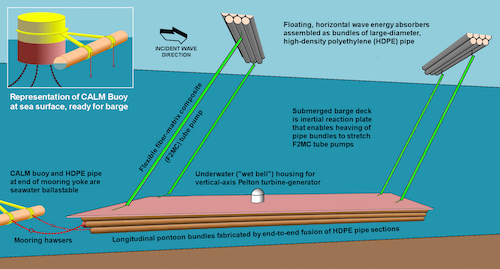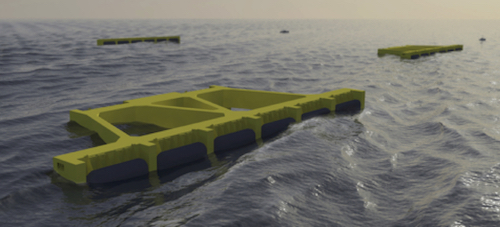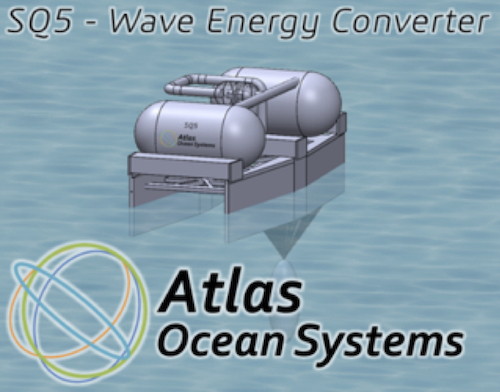It has been more than two months since the 20 Qualified Teams in the Wave Energy Prize were announced, and you are probably wondering what they have been working on. Well, they have been developing their 1/50th scale wave energy converter (WEC) models; preparing for testing these scale models; and starting to numerically model their innovative WEC designs. Below, in their own words, the Qualified Teams provide a glimpse into the breakthrough technologies they are developing (we present them alphabetically based on team name, and will do so for all Qualified Teams).
Advanced Ocean Energy @ Virginia Tech
Hampton Roads, Va.

Virginia Tech’s MULti-body LinEar Terminator (MULLET) is a self-contained array of Bundled pIpe Terminator Wave Energy Converters (BITWECs). Each BITWEC is a floating bundle of large-diameter high-density polyethylene (HDPE) pipes. The basic MULLET building block is a “tandem BITWEC” whereby two pipe bundles are arrayed one behind the other in the down-wave direction.
Each bundle is tethered by a pair of flexible fiber matrix composite tube pumps to the deeply submerged deck of a pontoon barge, which also is fabricated from large-diameter HDPE pipe sections, as shown in the conceptual diagram above, seawater output from the tube pumps is piped to an underwater habitat housing an accumulator and Pelton turbine-generator.
The MULLET barge is assembled while floating in calm water at dockside and then towed to its offshore installation site. Once on site, the barge is connected to a pre-set catenary anchor-leg mooring (CALM) buoy. The barge pontoons and CALM buoy are then flooded with seawater, submerging the barge to its mid-water operating position, where the barge deck acts as an inertial reaction plate for the floating bundles to work against, stretching the tube pumps. For inspection and maintenance, the barge and CALM buoy are re-floated to the surface by reversing the installation procedure.
AquaHarmonics
Portland, Ore.
AquaHarmonics’ Wave Energy Device is a point absorber device consisting of a simple Power Take Off (PTO) system mounted in a cone/cylinder shaped hull with a single mooring line that has a power cable at its core.
The PTO System consists of a sheave fixed to a shaft mounted in bearings within a sealed compartment and directly coupled to a pair of axial flux generators. The device only generates power on the rise of the wave, and during the fall of the wave the generators are operated as motors to reel in the mooring line for the next wave cycle.
During reel in, the control system of the device can provide additional energy input to achieve phase locking with any wave frequency. This control method is known as “de-clutching,” which has been shown to effectively increase the operational bandwidth of a wave energy device.
The generated power is far greater than that consumed during the wave cycle with some energy stored on board for periods of low wave activity. The power is conditioned on board and sent to shore via a slipring on the shaft connected to the power cable located at the core of the mooring line.
AquaHarmonics. Clean.Simple.Energy.
Atlantic Wavepower Partnership
Newport, R.I.
The AWS-III is a large-scale surface floating multi-absorber wave energy converter. Each absorber cell comprises a partially submerged air-filled chamber, one face of which is covered with a rubber diaphragm which flexes in response to the incoming wave actions. The movement of the diaphragm pumps air to and from the cell via an air turbine-generator set where the energy is converted to electricity. The cells are inter-connected via a ring-main such that air is exchanged between cells rather than with the outside environment.
All mechanical moving parts are isolated from the sea and contained within the device, whilst the turbine technology is tried-and-tested and available on the commercial market. The device is moored using traditional systems for offshore structures, either catenary systems and drag-embedment anchors or tension tethers and suction anchors. Accordingly, the device is utility-scale and has low technical risk and is capable of on-board maintenance of all parts with the exception of the diaphragms. Initial systems are expected to be rated at 2.0MW.
Atlas Ocean Systems
Houston, Texas
The Atlas Ocean Systems SQ5 Wave Energy Converter is a completely new device that captures energy primarily from pitch using two independent coupled oscillators. The SQ5 consists of three primary elements: 1) a float, 2) a new innovative submerged bag filled with air under pressure, and 3) a large submerged ballast.
The bag and submerged ballast are essentially in static buoyant equilibrium. The catamaran float provides roll stability and resonates in pitch with the waves and transfers vertical motion to the bag system which then excites a vertical oscillation of the submerged ballast. The oscillation of the ballast drives shape changes within the bag to pump air through a reversible flow turbine to generate useful energy. Pitch response of the float is adjustable in real-time using a ballasting system and coupling between the float and ballast is adjusted during design. Coupling between the two oscillating systems provides a wide dual-peak absorption spectrum providing good power output over a variety of sea states. There are no mechanical moving parts, seals, hinges, or pistons requiring lubrication or maintenance. The turbine system is protected within the pressurized pneumatic system and is suspended in a transverse mounting minimizing gyroscopic forces. The nominal system is designed for a 500kW-1MW rating.
Technical Summaries from more of the Wave Energy Prize Qualified Teams will be profiled in alphabetical order in the future. Visit the new Wave Energy Prize Team Updates page for more information.


